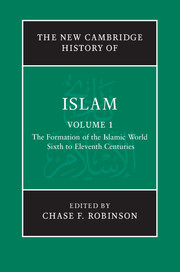Book contents
- Frontmatter
- Introduction
- PART I THE LATE ANTIQUE CONTEXT
- PART II UNIVERSALISM AND IMPERIALISM
- 5 The rise of Islam, 600–705
- 6 The empire in Syria, 705–763
- 7 The empire in Iraq, 763–861
- 8 The waning of empire, 861–945
- 9 The late ʿAbbāsid pattern, 945–1050
- PART III REGIONALISM
- PART IV THE HISTORIOGRAPHY OF EARLY ISLAMIC HISTORY
- Conclusion: From formative Islam to classical Islam
- Glossary
- Bibliography
- Index
- Plate Section
- References
9 - The late ʿAbbāsid pattern, 945–1050
from PART II - UNIVERSALISM AND IMPERIALISM
Published online by Cambridge University Press: 28 March 2011
- Frontmatter
- Introduction
- PART I THE LATE ANTIQUE CONTEXT
- PART II UNIVERSALISM AND IMPERIALISM
- 5 The rise of Islam, 600–705
- 6 The empire in Syria, 705–763
- 7 The empire in Iraq, 763–861
- 8 The waning of empire, 861–945
- 9 The late ʿAbbāsid pattern, 945–1050
- PART III REGIONALISM
- PART IV THE HISTORIOGRAPHY OF EARLY ISLAMIC HISTORY
- Conclusion: From formative Islam to classical Islam
- Glossary
- Bibliography
- Index
- Plate Section
- References
Summary
The decline and fall of the ʿAbbāsid caliphate in the first half of the fourth/tenth century led to the emergence of a new political order. The most fundamental change was the collapse of the resource base and fiscal system that had sustained the caliphate. The ʿAbbāsid caliphate had owed its wealth and hence its political survival to the revenues derived from the rich agricultural lands of the Sawād of Iraq. A rough calculation suggests that during the reign of Hārūn al-Rashīd this area produced a large proportion of the gross revenue of the caliphate, four times as much as the next most productive area, Egypt. During the course of the third/ninth and fourth/tenth centuries this happy state of affairs changed forever. The once-rich landscapes of the alluvial plain of southern Iraq were ruined and impoverished by a mixture of maladministration, military campaigning and lack of investment. Such meagre revenues as they continued to yield had been appropriated by the military nominally serving the government in Baghdad or by independent adventurers, and no longer filled the coffers of the state.
This economic decline profoundly affected the political geography of the Islamic world. Even under the Umayyads, whose courts were predominantly to the west in Syria, Iraq had been the resource base of the caliphate, and this status had been reinforced under the early ʿAbbāsids by investment in agricultural infrastructure. By the mid-fourth/tenth century, however, Iraq was probably no more productive than many other areas.
Keywords
- Type
- Chapter
- Information
- The New Cambridge History of Islam , pp. 360 - 394Publisher: Cambridge University PressPrint publication year: 2010
References
- 1
- Cited by



